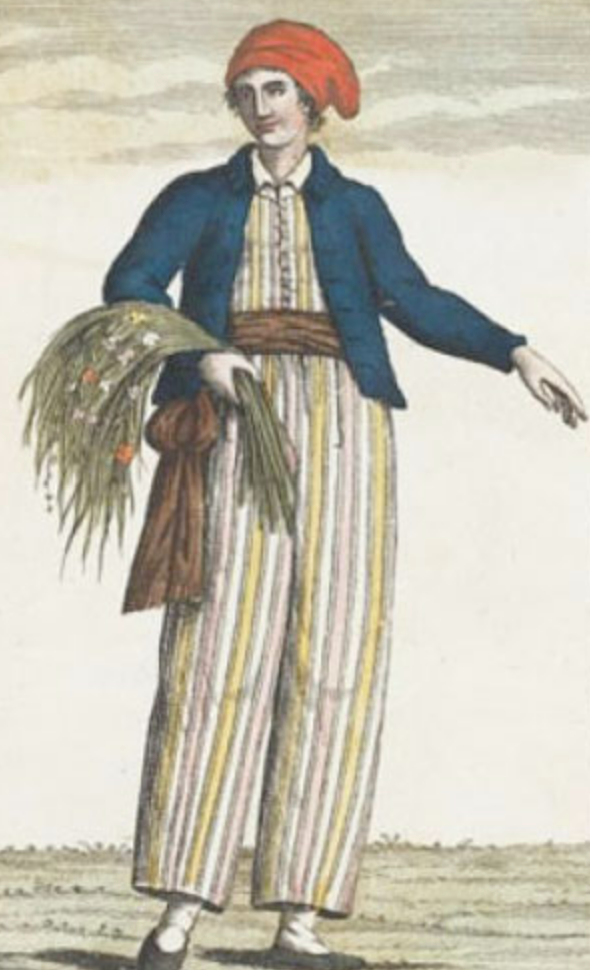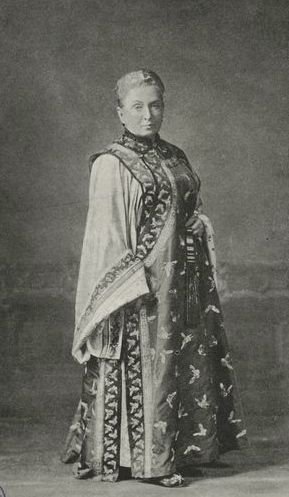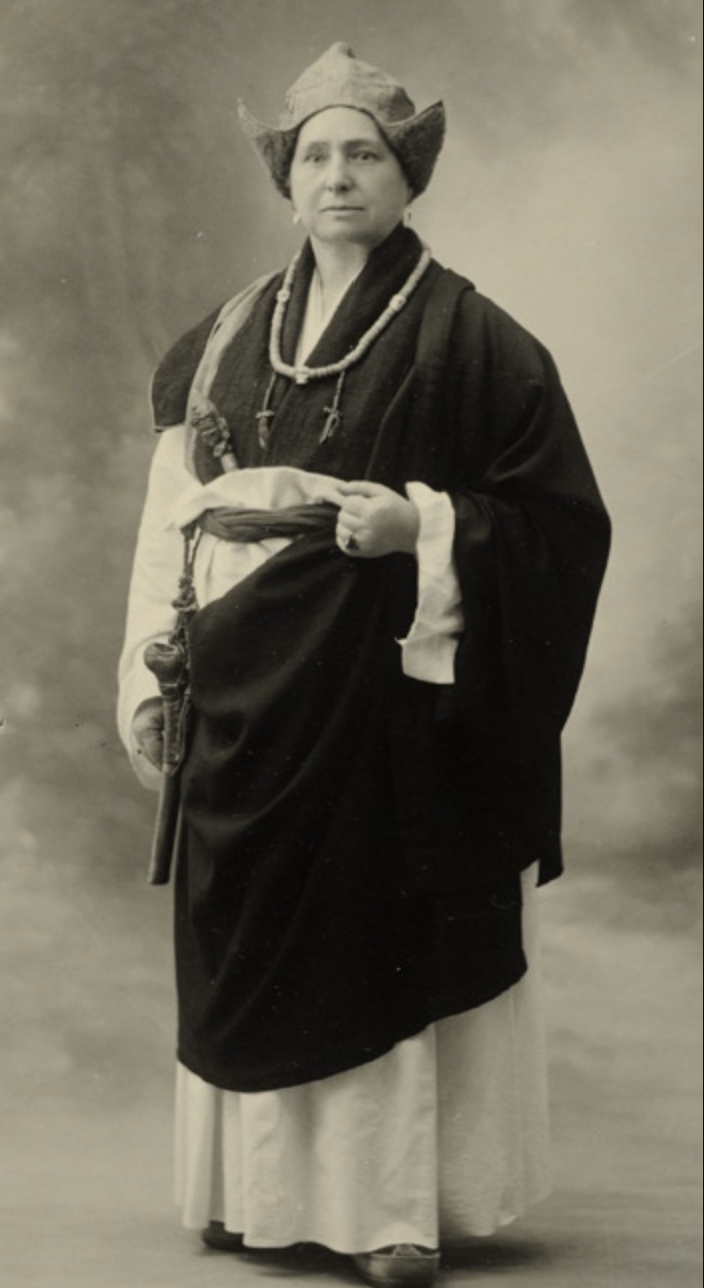Despite facing prejudice and skepticism, these intrepid women adventurers conquered the world’s toughest terrain.
In the world of adventure, where boundaries are meant to be broken, many consider exploration a male domain. But history tells us a different tale, one in which women have left their indelible mark and shattered that myth. From the unforgiving mountains of Tibet to the uncharted horizons, these trailblazing women displayed remarkable courage and tenacity, defying social conventions and breaking new ground.
1. Jeanne Baret,
French botanist and explorer
Born 1740
Jeanne Baret, dressed as a sailor, according to a portrait from 1817 made after her death. Unknown. CC BY 2.0.
While most people can recall the names of early explorers like Christopher Columbus, Ferdinand Magellan, and Vasco da Gama, few remember the accomplishments of Jeanne Baret, a French botanist and explorer who circumnavigated the globe and made significant botanical discoveries. Baret was a talented and ambitious young woman who escaped a life of rural poverty and joined naturalist and botanist Philibert Commerson on a French government-sponsored expedition aboard a storeship. To disguise her gender, Baret posed as Commerson’s male assistant, undertaking physically demanding work in the field, including carrying heavy wooden plant presses used to preserve botanical specimens. Despite the challenging circumstances, Baret accompanied Commerson on troublesome excursions over rugged terrain in Patagonia, earning his respect and admiration. After spending seven years in Mauritius, Baret returned to France, having collected over 6,000 plant specimens and identified numerous new species, including beaked dolphins and the Bougainvillea. However, much of her legacy was overshadowed by speculation about how she managed to conceal her gender for so long. It was not until 2012 that a species of nightshade, Solanum Baretiae, was finally named after her, finally giving Baret the recognition she earned long ago.
2. Ida Laura Pfeiffer,
Austrian explorer
Born 1797
Ida Laura Pfeiffer. Unknown. CC BY 2.0.
Ida Laura Pfeiffer, an Austrian explorer, is widely recognized as a trailblazer in the realm of female travel writing. Born on October 14, 1797, in Vienna, Pfeiffer embarked on her first extensive journey to Palestine and Egypt at the tender age of five, planting the seeds of her insatiable thirst for adventure and exploration. On May 1, 1820, she was forced into an unwanted marriage, and her true spirit was unleashed only after she gained freedom from the responsibility of caring for her family. At the age of 45, Pfeiffer set out on a solo journey along the Danube river to Istanbul, a time when it was unheard of for a woman to travel unaccompanied. Pfeiffer’s insights from this journey were published in “Journey of a Viennese Woman to the Holy Land” in 1843. Her accounts were unique in their honesty and self-awareness, describing herself as aged, destitute, and unappealing, with no claims to literary genius or knowledge. However, she turned her age, bravery, and spirit of self-reliance, which developed from a life full of hardships, to her advantage. From 1843 to 1855, Pfeiffer traveled over 150,000 miles of sea and 20,000 of land, covering Southeast Asia, the Americas, the Middle East, and Africa, including two trips around the world. Her stories were initially published in German and later translated into English, French, and other languages. Her collections of objects, plants, and insects from around the world earned recognition from the scientific community and were exhibited at the museums of Vienna.
3. Isabella Bird,
British explorer
Born 1831
Isabella Bird in Chinese attire. Timony Takemoto. CC BY-NC 2.0.
Isabella Bird was a British explorer born on October 15, 1831, in Boroughbridge Hall, Yorkshire, who spent much of her life traveling the world—a career that was almost unheard of for a woman in her time. For Bird, her decision to make travel a lifelong profession was largely personal, as she suffered from health issues like headaches, insomnia, and a spinal problem, which Victorians referred to as “a sensitive and nervous temperament.“ Her doctors suggested a sea voyage to help improve her condition, and at the age of 23 in 1854, she embarked on her first international journey to America. She gained fame as a 4ft 11 Victorian adventurer who rode 800 miles across Colorado on a horse, scaled Longs Peak, and chronicled her experiences in a book called “A Lady’s Life in the Rocky Mountains”. She traveled to countries such as America, Hawaii, India, Kurdistan, the Persian Gulf, Iran, Tibet, Malaysia, Korea, Japan, and China throughout her life. By the time the tireless lady passed away at the age of 73, she had become the first female member of the Royal Geographical Society.
4. Alexandra David-Neel,
Belgian-French explorer
Born 1868
Alexandra David-Neels. Preus museum.CC BY 2.0.
Alexandra David-Neel was a multi-faceted personality, with many achievements to her name. She was a writer, an opera singer, an anarchist, a Buddhist, and an intrepid female explorer who ventured to Lhasa in Tibet. Born in a Parisian suburb during the Victorian Era, David-Neel found her calling during her field trips to the Guimet Museum of Asian Arts. At the age of 23, she used a small inheritance from her godmother to study Sanskrit, an unusual pursuit for French women even in modern times. Later, when her money ran out, she returned to Belgium to study music at the Royal Conservatory of Brussels, where she became a professional opera singer. Her passion for Asian culture continued as she held the position of the first singer at the Hanoi Opera in Vietnam for two seasons. David-Neel was also passionate about education, and she lectured at the Theosophical Society in Paris and London. However, feeling that her knowledge of Buddhism and Asian culture was insufficient, she separated from her husband in 1911 and returned to India. There, she became the disciple of a Buddhist monk and lived in a cave for two years. As if this wasn’t enough, David-Neel colored her face with charcoal, braided her hair, and disguised herself as the servant of Aphur before entering Lhasa. She achieved this remarkable feat at the age of 56, becoming the first Western woman to enter a place that had been entirely forbidden to foreigners. David-Neel died on September 8, 1969, at the age of 100. As per her wishes, her adopted son Peyronnet scattered her ashes in the Ganges River along with those of her adopted son. Barbara and Michael Foster wrote in their book The Secret Lives of Alexandra David-Neel: A Biography of the Explorer of Tibet that, “The woman shed her past lives like a serpent sheds its old skin. In each life, she buried the previous one, concealing its traces."
5. Kate Rice,
Canadian prospector
Born 1882
Portrait of Kate Rice a Prospector, Trapper, and Adventurer. Unknown. CC BY 2.0.
Kathleen (Kate) Rice defied the odds by participating in the gold rush during a time when women were not permitted to own land. Her passion for travel can be attributed to her father, who valued education and instilled in her a love for nature. While studying mathematics, physics, and astronomy at the University of Toronto in the early 1900s, Rice’s thirst for adventure drew her to the mesmerizing wilderness. She settled near the Rocky Mountains in 1911 to teach, which inspired her to explore mountaineering. Rice joined the Alpine Club of Canada and discovered her passion for outdoor life. After teaching for just five years, she left her job and ventured north to establish a homestead, relying on the support of the Indigenous people in the area. Rice’s daring expedition led her over 800 kilometers north of The Pas to Reindeer Lake, where she discovered zinc and vanadium. Additionally, she authored scientific papers on the northern lights and worked as a journalist, contributing articles to the Toronto Star. She also expanded her accomplishments by working as a commercial fisher and growing produce for the market. Rice is the second woman to receive the honor of induction into the Canadian Mining Hall of Fame in 2014.
6. Jane Gardner Batten,
New Zealand aviator
Born 1909
Jean Batten after her successful England to Australia flight, Mascot, Sydney, 1934. Sam Hood.CC BY 2.0.
Jean Gardner Batten was a daring New Zealand aviator who captured worldwide attention with her fearless solo flights during the 1930s. She gained notoriety after setting a new record for a solo flight from England to Australia. However, achieving this feat was no easy task. On her first attempt to break the record, Batten encountered a sandstorm that caused her aircraft to spin out of control. She managed to regain control just in time to make an emergency landing in the desert, where she spent the night under her plane's wing. Despite facing additional challenges and engine failure, Batten refused to give up on her dream. Her passion for aviation was sparked when she met Charles Kingsford-Smith, an acclaimed aviator and national hero of Australia, at a social event in Auckland in 1928. Despite receiving warnings from Smith not to fly at night or attempt to break any male pilot's records, Batten pursued her ambition. Her daring achievements were extensively covered by newspapers, and she was awarded the Gold Air Medal by the Federation Aeronautique Internationale, becoming the first woman to receive the prestigious honor.
7. Dian Fossey,
American primatologist and conservationist
Born 1932
Dian Fossey with blackback gorilla Peanuts, Rwanda, 1970. Felton Davis. CC BY 2.0.
An animal lover from a young age, Dian Fossey began her career as an occupational therapist. On the summer break following her freshman year of college, she went to work on a ranch in Montana, where she fell in love with and developed an attachment to the animals. In 1967, Dian Fossey went to Africa to conduct studies of gorilla behavior. She visited Kenya, Tanzania (then Tanganyika), Congo (then Zaire), and Zimbabwe (then Rhodesia) during that trip, and meet Dr. Louis Leakey, a Kenyan-British palaeoanthropologist and archaeologist whose work was important in demonstrating that humans evolved in Africa. She was fascinated by the gorillas, and eager for a chance to do field research on them. She later explained her draw to gorillas in her 1983 autobiographical work, “Gorillas in the Mist”: “It was their individuality combined with the shyness of their behavior that remained the most captivating impression of this first encounter with the greatest of the great apes,” Fossey said. For more than 20 years, Fossey lived among the mountain gorillas of the Virunga mountains, at first studying the great apes and then, slowly becoming their friend and protector. She found the Karisoke Research Center in 1967, located in the Parc des Volcans in Rwanda. The park is located on the border of Zaire, within 10 miles of Uganda. Fossey later based her anti-poaching patrols there as headquarters to stop the slaying of gorillas. As a researcher, her pioneering work with the gorillas has forever changed the ways animals are studied in the wild. Her observations of gorillas’ behavior dispelled myths about the creatures’ inherent violence. Fossey made several notable contributions to gorilla research, including gorilla vocalizations, rare infanticide, gorilla diets, and how gorillas recycle nutrients. In 1970, Fossey was on the cover of National Geographic Magazine, which garnered a lot of attention to her and her work. Tragically, on December 26, 1985, Fossey was found murdered, presumably by poachers, at her Rwandan forest camp. No assailant has ever been found or prosecuted in her murder. Today the Dian Fossey Gorilla Fund, in which Fossey's name lives on, is dedicated to the conservation, protection, and study of gorillas and their habitats in Africa.
8. Junko Tabei,
Japanese mountaineer
Born 1939
Junko Tabei. Jaan Kunnap.CC BY-SA 4.0.
In a world where western male mountaineers dominate historical records, the name Junko Tabei may not ring a bell to most students of mountaineering history. However, this Japanese mountaineer, teacher, and author was a trailblazer who made history by becoming the first woman to conquer Mount Everest. Born into a family of seven in Fukushima prefecture, Japan, Tabei was determined to prove her physical abilities despite being considered fragile. Her love for mountaineering took her to Nepal, which inspired her to challenge traditional gender roles by establishing the Japanese Women’s Everest Expedition in 1975. During the climb to Mount Everest, an avalanche buried Tabei and left her injured and unable to walk for two days. But her indomitable spirit kept her going, and she crawled on her hands and knees to reach the summit of Mount Everest, accomplishing what no woman had before. Tabei’s bravery and resilience extended beyond mountaineering, as she also advocated for environmental protection and led initiatives to clean up the trash on Mount Everest. She organized yearly climbs to Mount Fuji for school children affected by the Great East Japan Earthquake, showing her commitment to making a positive impact on society. Tabei’s remarkable achievements earned her the recognition of having both an asteroid and a range of mountains on Pluto named after her.
9. Gerlinde Kaltenbrunner,
Australia mountaineer
Born 1970
Gerlinde Kaltenbrunner 2015. Franz Johann Morgenbesser. CC BY-SA 2.0.
Growing up in a small resort community nestled in the Alps of central Austria, Gerlinde Kaltenbrunner discovered her passion for mountain climbing at a very young age. At the age of 13, she ventured on her first climb at a local mountain, which ignited her enthusiasm for climbing and paved the way for her journey into alpinism. She became known as a mountaineer with an unwavering spirit, always seeking new peaks to conquer.
Kaltenbrunner made history as the first woman to conquer all 14 eight-thousanders, which the International Mountaineering and Climbing Federation (UIAA) recognizes as mountains that are more than 26,247 ft (8,000 kilometers, as in the name) in height above sea level, without the use of oxygen or a trained nurse. Among the most famous peaks that she conquered is the deadly Annapurna situated in the mountain range of Gandaki Province, north-central Nepal, which stands at 26,545 ft high with a death rate of 31.9%. Kaltenbrunner achieved this incredible feat in 2007.
Aside from her love for climbing, Kaltenbrunner was not solely dedicated to her passion for climbing; she also aspired to build a daycare center in Nepal for children and young adults with disabilities. Her mountaineering pursuits were never about achieving record-breaking feats. Instead, she sought to promote harmonious coexistence between people and nature.
Though their journeys took place in different historical periods, some over a century ago, these female explorers’ legacy lives on, inspiring future generations to push beyond their limits and pursue greatness. Their stories also remind us of the ongoing struggle for equality and recognition that women continue to face in various fields, and the importance of continuing to push for change, for greater representation and opportunities for women, and for a world in which women's contributions are valued and celebrated.
Hope Zhu
Hope is a Chinese international student at Wake Forest University in North Carolina studying sociology, statistics, and journalism. She dreams of traveling around the globe as a freelance reporter while touching on a wide range of social issues from education inequality to cultural diversity. Passionate about environmental issues and learning about other cultures, she is eager to explore the globe. In her free time, she enjoys cooking Asian cuisine, reading, and theater.











